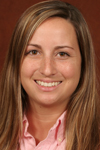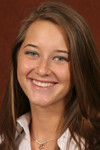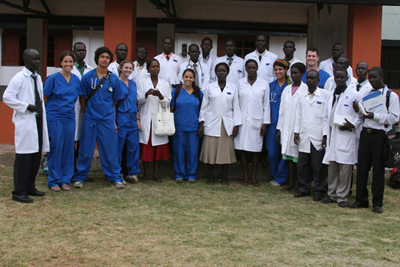
|
STUDENT NEWS |
|
APPOINTMENTS
Ashley Lucke, Class of 2011, has been appointed to the American
Academy of Pediatrics Medical Student
She was president of the College of Medicine’s Pediatric Interest Group in 2008-09, when it became the medical school’s student organization of the year. What will she do in this new role?
"My job is to connect all of the pediatric interest group presidents
nationally – something I really wish had been available when I was
president. I plan to make a listserv and Facebook page to allow students to
collaborate and find new ideas for their campus groups. Additionally, I hope
to increase national awareness of the AAP and the benefits of medical
student membership. We will also be responsible for
Alyson Lewis, Class of 2012, has been appointed by the American Academy of Family Physicians as a Family Medicine Interest Group regional coordinator.
PRESENTATIONS Komal D'Souza, Class of 2011, will provide an oral presentation at April’s annual conference of the Society of Behavioral Medicine in Seattle. Her presentation is based on the research she conducted during her College of Medicine summer fellowship in 2008. Most important, her presentation was selected as a Meritorious Student Presentation and will be recognized as such during a special session of the conference.
"I’ll be presenting the research project I worked on alongside Dr. [Gareth] Dutton and Dr. [Maggie] Blackburn," D'Souza said in an e-mail. "Our project is titled 'Pilot Study Examining Dance-Based Video Games to Promote Physical Activity among Children in a Rural School-Based Setting.' The goal of the project was to evaluate if the interactive video game 'Dance Dance Revolution' was effective in increasing physical activity levels among kids in Gadsden County. I really enjoyed working with the kids on this research project, and I'm honored to get the opportunity to share our research in Seattle."
ACADEMIC ACHIEVEMENTS Kara Dalke, Class of 2010, has completed her MPH from the University of South Florida College of Public Health and received her diploma. She also passed the 2009 National Public Health Certification Exam as administered by the National Board of Public Health Examiners and received her CPH certificate.
Uchenna Ikediobi, Class of 2010, also completed her MPH from Emory University.
IN THE MEDIA
Sarah McIver, Class of 2011, was mentioned in an article in the Oct.
15, 2009, issue of Vero Beach 32963. It
"In addition to the five attending physicians, third- and fourth-year medical students from the Florida State University College of Medicine rotate through the center to observe and evaluate patients under the guidance of Dr. [Wayne] Creelman. Third-year FSU medical student Sarah McIver just started her psychiatric rotation at the center. She spends her mornings working with patients at the hospital's psychiatric facility and her afternoons sitting in on outpatient sessions with Dr. Creelman. Even in the short time she's been in Vero, McIver said she’s been touched by the impact the center is making.
"'I was amazed at the number of children with serious mental health problems who are in need of treatment,' she said.
"To better serve those children and also adolescents, Creelman is working on developing programs which the center can offer to target the mental health needs of Indian River County’s youngest residents."
The medical team from the College of Medicine worked with a group of clinical officer students (equivalent to physician's assistants in the U.S.) to help communicate with and treat the patients who entered the clinic in Uganda.
LEARNING THROUGH SERVING The Story of the Ugandan Invisible Children and the 2009 Medical Relief Trip Excerpts from a piece written by Natasha Demehri, Class of 2012
For the boys and girls of northern Uganda, nightfall has become terrifying. For 23 years, a man named Joseph Kony has been terrorizing Africa, leading what he calls a holy war in an attempt to create a "theocratic state" based on the Ten Commandments and Acholi tradition. Kony's army is called the Lord's Resistance Army, and 90 percent of the soldiers are children ages 6-18. More than 30,000 children have been abducted from their homes at night and been brainwashed into becoming child soldiers or sex slaves. Then they're sent back to terrorize their communities, kill their own families and abduct more children. The results have been horrifying, and the psychological trauma incalculable. Young women who were attacked by the child soldiers had their ears, noses and lips cut off if they tried to escape or resist sexual enslavement. The government of Uganda was forced to shelter 2 million villagers in Internally Displaced Camps, better known as IDP camps. Although the camps provided safety from the LRA, disease and starvation there led to the death of nearly 1,000 people every week. In 2007 the LRA left the villages of Northern Uganda, but it left behind a great deal of trauma. In the summer of 2009, eight medical students from FSU's College of Medicine accompanied physicians, pharmacists, nurses, psychologists and lab technicians to bring as much medical care as possible to Gulu, the Ugandan city most affected by the war. We arrived with $500,000 worth of medical supplies and tests and set up clinic in an abandoned school. Throughout the week we were assisted by a group of clinical officer students, the equivalent of physician's assistants in the U.S., who proved to be invaluable medical resources and Acholi translators. Some of the most serious illnesses we treated were malaria and Kaposi's Sarcoma, a cancer in end-stage AIDS patients rarely seen in the U.S. Other patients arrived with illnesses ranging from tinea capitis to atrophic vaginitis. With the help of a local lab technician from Kenya, we used an ultrasound to diagnose Burkett's Lymphoma in an 11-year-old girl and several other pregnancy-related problems in young women. In addition to medical treatment, we had set up an area for HIV/AIDS education and another area for a mental health team. Every person who entered the clinic got a 10-day supply of multivitamins, mebendazole de-worming treatment and Vitamin A (unless they were females of reproductive age). Through our clinic we treated 1,749 patients and gave 93,000 vitamins, 300 pairs of reading glasses, 300 pairs of sunglasses, more than 400 pounds of medicine, and 5,510 packages of seeds to help them grow their own food. We also completed 281 lab tests, did 74 ultrasounds, fed more than 1,000 people, de-wormed 975 villagers and counseled more than 100 trauma victims. After our work in the clinic, our medical team visited the Laroo School for War Affected Children. A team from Dublin was also working at the school that week, and some of us helped them with their project to use music and art to desensitize the children to the war. All the games we played and music we learned incorporated balloons, drums and loud noises in an attempt to associate a previously traumatizing noise with something free of fear and violence. After the war ended two years ago, the government stopped recognizing the IDP camps in an attempt to force the displaced villagers to return home. To date, only 900,000 of the 2 million displaced people have returned to their communities. Without adequate food or economic resources, the IDP camps have turned into health nightmares. Every single child we saw was severely malnourished. We used the rest of our medications from the clinic to de-worm every person we could, as well as provide them with Vitamin A and 10-day supplies of multivitamins. We also fed the displaced villagers with beans, rice and meat we had bought so they'd have at least one nutritious meal – for which they were extremely grateful. I came to Uganda intending to bring aid and change to the people of Gulu, but I was the one who was changed. I left with a new sense of gratitude, appreciation and hope from the incredible families I had met over my two-week trip. In spite of horrid health conditions, traumatic histories and lost loved ones, the villagers of northern Uganda were some of the most patient, kind and peaceful people I have ever encountered.
About the photo on the front page: Natasha Demehri is pictured with a woman who was mutilated by the soldiers of the rebel army years ago by having her ears, nose and lips cut off. After years of charity surgery, her face was almost completely reconstructed, and she came to the clinic to thank the medical team for dedicating their time to help her community. |
 |
 |
 |
| E-mail Alumni Affairs Phone: 850-645-9428 | ||
|
|
|
Florida State University
|
College of Medicine
|
Copyright 2013
|
 Subcommittee
as a Networking Workgroup representative. "There were 3 spots open for
applications from any medical student in the country," she said in an
e-mail, "and I was lucky enough to get one!" She said she can’t wait to
start.
Subcommittee
as a Networking Workgroup representative. "There were 3 spots open for
applications from any medical student in the country," she said in an
e-mail, "and I was lucky enough to get one!" She said she can’t wait to
start. distributing
the material created by the Education and Opportunities Committee to PIGs
nationally. Ultimately, the best thing about being a subcommittee member is
knowing how many more students will have the opportunity to explore
everything pediatrics has to offer."
distributing
the material created by the Education and Opportunities Committee to PIGs
nationally. Ultimately, the best thing about being a subcommittee member is
knowing how many more students will have the opportunity to explore
everything pediatrics has to offer." focused
on the University of Florida Center for Psychiatry and Addiction Medicine in
Vero Beach. Here’s the excerpt that includes McIver:
focused
on the University of Florida Center for Psychiatry and Addiction Medicine in
Vero Beach. Here’s the excerpt that includes McIver:
